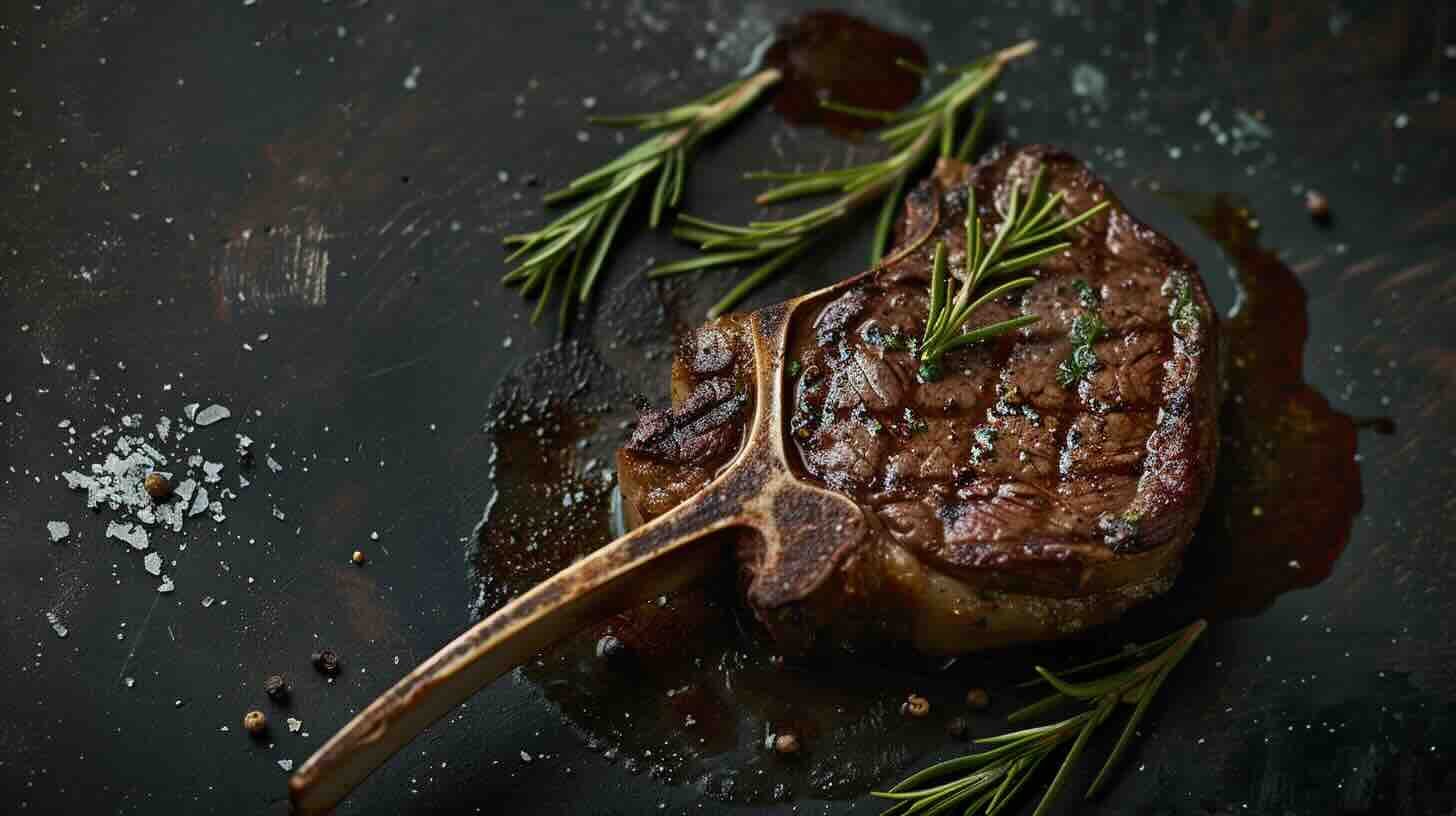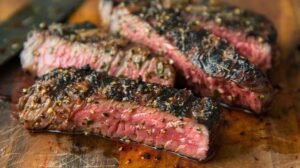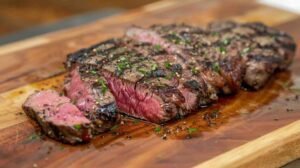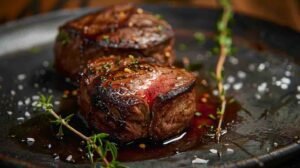The Art of Reverse Searing
Understanding Reverse Searing
Reverse searing is a highly effective technique for achieving a perfectly cooked steak, especially when dealing with a reverse sear tomahawk steak. The process involves cooking the steak indirectly at a low temperature before finishing it with a high-heat sear. This method ensures a more evenly cooked steak throughout, retaining moisture and enhancing flavor.
The steps to reverse searing typically include:
- Preheat the Oven or Smoker: Set the temperature to around 225°F.
- Cook the Steak Slowly: Place the steak in the oven or smoker and cook it indirectly until the internal temperature reaches between 110°F and 115°F (MyChicagoSteak).
- Sear the Steak: Move the steak to a grill or cast-iron skillet preheated to high heat (approximately 600°F) and sear each side for a few minutes until the internal temperature reaches 135°F for a medium finish.
Benefits of Reverse Searing
Reverse searing offers several advantages over traditional searing methods:
- Even Cooking: By slowly bringing the temperature of the meat up in a low-temperature environment, the steak is more evenly cooked from edge to edge. This eliminates the gradient of doneness typically seen in traditional searing (Kosmos Q).
- Moisture Retention: The gradual cooking process helps retain moisture within the steak, resulting in a tender and juicy bite.
- Perfect Crust: The final high-heat sear creates the Maillard reaction, producing a beautifully charred crust that enhances the steak’s flavor.
- No Need for Resting: Unlike traditional methods, reverse searing allows the steak to be served immediately after searing, as the meat’s internal juices are already well-distributed.
| Method | Internal Temp Before Searing | Searing Temp | Final Internal Temp (Medium) |
|---|---|---|---|
| Reverse Sear | 110-115°F | 600°F | 135°F |
For those who love steak, reverse searing is a game-changer. It provides a consistent, flavorful, and perfectly cooked steak, making it an ideal choice for preparing a tomahawk ribeye or other premium cuts. For more information on different types of steaks, check out our articles on reverse sear filet mignon and reverse sear ribeye steak.
Tomahawk Steak Overview
What is a Tomahawk Steak?
A tomahawk steak is a piece of tender rib meat that hasn’t been fully removed from the bone. This cut, also known as a bone-in ribeye steak, features a rib bone left almost fully intact and still attached to the meat, creating a stunning presentation (Hey Grill Hey). The long bone, while not contributing to the flavor, significantly enhances the visual appeal of the steak. Ribeyes are commonly used for this type of steak, making it a popular choice for special occasions and gourmet meals (MyChicagoSteak).
| Type of Steak | Description |
|---|---|
| Tomahawk Steak | Tender rib meat with almost fully intact rib bone |
| Ribeye Steak | Boneless or bone-in with rich marbling |
Selecting and Seasoning the Steak
Selecting the right tomahawk steak is crucial for achieving the best results with the reverse sear technique. Look for a steak with good marbling, as the fat interspersed within the meat ensures a juicy and flavorful result. The thickness of the steak is also important; aim for a cut that is at least 2 inches thick to allow for even cooking and optimal searing.
When it comes to seasoning, simplicity is key. Start by patting the steak dry with paper towels to remove any excess moisture. Generously season the steak with kosher salt and freshly ground black pepper. You can also add other seasonings to your preference, such as garlic powder, onion powder, or smoked paprika.
For a detailed guide on how to properly season and prepare your steak, you can refer to our reverse sear steak recipe.
| Step | Action |
|---|---|
| 1 | Pat the steak dry with paper towels |
| 2 | Generously season with kosher salt and black pepper |
| 3 | Optionally, add garlic powder, onion powder, or smoked paprika |
By understanding what makes a tomahawk steak unique and learning how to select and season it properly, you are well on your way to mastering the art of the reverse sear tomahawk steak. For more information on different steak cuts and techniques, visit our sections on reverse sear filet mignon and reverse sear ribeye steak.
Mastering the Reverse Sear Technique
Step-by-Step Guide to Reverse Searing
Reverse searing is the preferred method for cooking a tomahawk steak, ensuring it is evenly cooked and retains its moisture. Here is a step-by-step guide to mastering the reverse sear technique:
- Preheat Oven or Smoker: Preheat your oven or smoker to 250°F. This low temperature allows the steak to cook slowly and evenly.
- Season the Steak: Generously season your tomahawk steak with salt, pepper, and any other preferred seasonings. This enhances the flavor during the slow-cooking process.
- Cook Indirectly: Place the steak on a baking sheet or in a smoker, ensuring it is not directly over the heat source. Cook until the internal temperature reaches 110-115°F.
- Rest the Steak: Remove the steak from the oven or smoker and let it rest for 10-15 minutes. This helps redistribute the juices throughout the meat.
- Preheat Grill or Skillet: Preheat your grill or a cast-iron skillet to a high temperature, around 600°F, for a perfect sear.
- Sear the Steak: Place the steak on the hot grill or skillet, searing each side for 1-2 minutes until a nice crust forms. Aim for an internal temperature of 135°F for medium doneness.
Monitoring the Cooking Process
Monitoring the temperature is crucial for achieving the perfect reverse sear tomahawk steak. Here are some tips:
- Use a Meat Thermometer: Insert a meat thermometer into the thickest part of the steak to accurately monitor the internal temperature.
- Temperature Guide: Refer to the following table for desired doneness levels:
| Doneness Level | Internal Temp (Before Searing) | Final Internal Temp |
|---|---|---|
| Rare | 105-110°F | 125°F |
| Medium Rare | 110-115°F | 135°F |
| Medium | 120-125°F | 145°F |
| Medium Well | 130-135°F | 150°F |
| Well Done | 140-145°F | 160°F |
- Visual Cues: Look for a well-browned crust on the exterior of the steak. This indicates that it has been properly seared.
For more tips on achieving optimal results, check out our article on how to reverse sear steak. Additionally, you can explore other steak recipes such as the reverse sear ribeye steak or reverse sear filet mignon to expand your culinary skills.
Perfecting the Tomahawk Steak
Resting and Serving Your Steak
Resting the tomahawk steak after removing it from the sear is crucial for achieving the best results. Allowing the steak to rest ensures that the juices redistribute throughout the meat, resulting in a flavorful and tender final product. According to Hey Grill Hey, this step is essential for a succulent steak.
After completing the reverse sear process and the final sear, a 10-minute rest period is recommended. This allows the steak to achieve a medium finish, providing a rich and tender eating experience.
| Step | Recommended Time |
|---|---|
| Final Sear | 2-3 minutes per side |
| Resting | 10 minutes |
When it comes to serving, consider slicing the steak against the grain. This method ensures each bite is tender and easier to chew. Given the large size of a tomahawk steak, it can easily serve multiple people. For example, two 45 oz tomahawk steaks can feed five to six people when paired with side dishes.
Tips for Achieving Optimal Results
To achieve the best results when reverse searing a tomahawk steak, consider the following tips:
- Seasoning: Liberally season the steak with sea salt about 9 hours before cooking. Allow it to sit for two hours at room temperature before starting the grilling process (Smoke Fire Grill).
- Cooking Temperature: Use a low, indirect heat of 225°F to cook the steak until it reaches an internal temperature of 120°F. This slow cooking process ensures even heat distribution and a tender texture.
- Final Sear: Sear the steak over high heat (600°F+) until it reaches the desired serving temperature. For a medium-rare finish, aim for an internal temperature of 130°F.
- Resting: Allow the steak to rest for about 10 minutes after the final sear. This step is crucial for letting the juices redistribute, resulting in a more flavorful and tender steak.
- Serving: Slice the steak against the grain for optimal tenderness. Consider pairing the steak with complementary side dishes to enhance the dining experience.
For more detailed instructions, check out our guide on how to reverse sear steak and reverse sear steak recipe. By following these tips, you can master the art of reverse searing and enjoy a perfectly cooked tomahawk steak every time.



